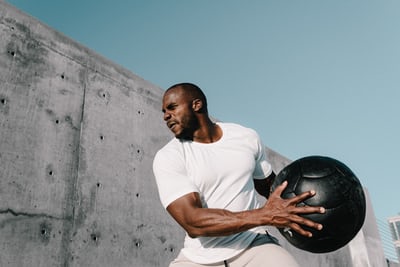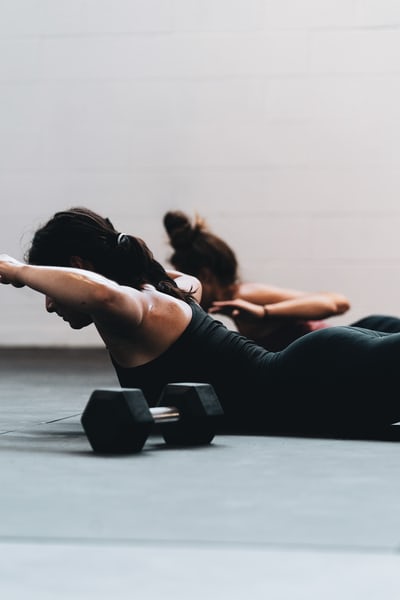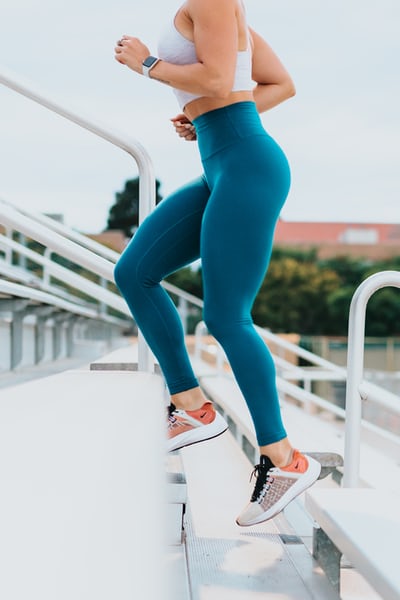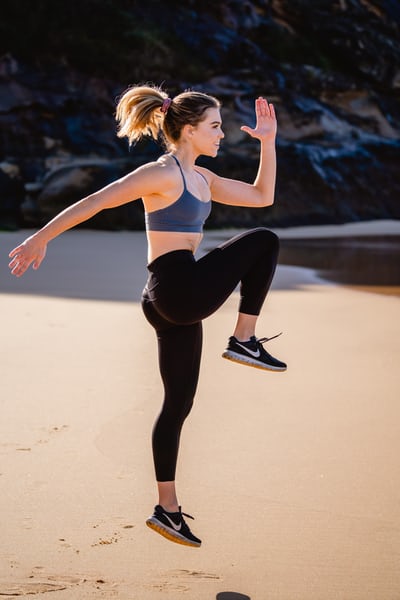When you start with high-impact warm-up stretches like leg curls, leg swings, shoulder/arm circles, jumping jacks, jump rope, lunges, or squats, it is important to start slow and gradually build in more days of training. Don’t start everything immediately! You should start your exercise off slowly and steadily, or else you may dramatically increase the risk of injury.

Getting injured is never a nice thing, especially when it is avoidable. When you injure yourself during a warm-up, the best thing to do is to immediately stop the warm-up stretch and summon the attention of a medical specialist to attend to you to find a speedy solution to the pain. If you try to push through it, you may have to quit working out for weeks or even months.
When we start doing the warm-up stretch, in one way or another, we have to learn to improve our physical fitness and our mental health, contributing to our health and daily lifestyle in all aspects.
The first piece of advice is to get a medical check-up before starting CrossFit. It is also important to consult a specialist whenever you notice any sports injury that does not heal over time.
The second recommendation is that there should be a relationship between you and your medical specialist on the physical condition to be achieved in the case of a medical problem.
Knowing when you have injured yourself in a sports injury and seeking medical help is vital. This way, you will get the correct treatment, speeding up the healing process. Ignoring and self-medicating will only make the spot of injury more painful over time, and this can cause more damage to the injured part.
Importance of choosing the right gym (box) and coach
Many sports injuries can be avoided by following this advice:
- It is essential to choose the box wisely.
- The box should be very professional to help improve and advise on personal needs. Doing the exercises wrong, with too much intensity, can cause injury.
- A high number of athletes per box means that sports practice is not personalized.
- The coach must have adequate training to perform the correct mechanics in each exercise. The key to a good coach is that they won’t let the student get upset and want to “throw more than they can”, ignoring technique.
- The risks decrease with a personalized coach.
- CrossFit is a very competitive and motivating sport. Some athletes publish the latest advances very quickly on social networks. This means that people want to copy these achievements, sometimes without acquiring the necessary skills.
- When a person is trying to push their limits, the risk of injury is greater regardless of technique.
Sports injury is a possibility in all sports. However, the danger may be considerably reduced with proper technique, training strategy, and a qualified coach. CrossFit, like other sports and physical activity in general, promotes health and quality of life; however the risks of injury vary depending on several factors:
1. Injury due to lack of coordination.
CrossFit offers a wide variety of different movements to work the whole body. But every move requires coordination to perform the reps with the correct movement pattern. When starting CrossFit training, you risk injuring yourself by not executing the technique well if you don’t have a strong athletic background.
Body coordination is improved by moving a lot and making efforts to do it better and better. The more you move, the better your body coordination will be.
The tips we give you will help you to avoid these sports injuries.
Relax. Training, being in shape and having a healthy life is a path, not a goal. If you try to run before you walk, you risk injuring yourself.
Listen and observe your coach. He or she has experience in the movements you need to do and can give you the right advice to improve. It is important that you observe and also try to reproduce their movements.
Put a light weight on the bar first and do slow repetitions. First, start by moving well, gaining coordination and little by little, you will see that you can gain weight.
Choose the right place and the right person; when you start doing CrossFit in a box, everything you find there feels wonderful, but maybe that’s because it’s the only thing you knew until now. The person in charge of the training must have adequate training and experience to explain and correct your technique and develop a training “with meaning”.
2. Injuries due to lack of mobility
Mobility is your ability to exert force in certain ranges of motion. This implies that your joints will be more stable.
The most difficult Olympic lifts performed in CrossFit require basic mobility. This involves some warm-up stretches and the ability to exert force in this position.

If we lack mobility in the positions that we have to force ourselves, we can make bad gestures that cause us to hurt ourselves.
How to improve mobility?
Stretch daily. With 15 minutes of mobility a day, it’s enough to improve a lot in a short time. Of course, they must be 15 minutes scheduled, knowing what we are doing. One tip is to include it in your warm-up when doing dynamic mobility or put it on at the end of your workout as a cool-down if you’re doing fixed mobility exercises.
3. Overload injury.
Overuse injuries occur when the amount of daily warm-up stretches is excessive over time. We subject the body to a certain physical and mental stress level when we train. Your body is an organic machine that improves after being subjected to controlled stress. In this way, you are more and more tolerant of this effort, which allows you to be in better physical and mental shape.
But if you repeatedly exceed the level of stress your body is prepared for without letting it rest properly, you run the risk of injury.

It could be from training harder than your body is prepared for, in which case the sports injury appears the same day. Or it could be due to prolonged overtraining because you train too many days in a row, and you give your body very little rest, and it ends up hurting itself.
To avoid this type of injury, we always recommend calm but no less determination. In both situations, the body warns and then it is time to reduce the intensity of the workout or the volume of the warm-up stretches. The warnings are usually discomfort or pain such as muscle overload, burning sensation or stiffness.
The technique in CrossFit is basic to avoid injuries
CrossFit is a very disciplined sport, and the steps to follow should be as follows:
- Technical. Mastering the technique is fundamental.
- Consistency. With proper technique, an activity can be performed consistently.
- Intensity. Once an activity is performed consistently, always following the technique, the intensity can be increased.
- Only if the previous three points are fulfilled can the weight be increased.
- You need to learn the mechanics of the basic movements, establish a consistent pattern of practicing these movements, and only then can you increase the intensity of the workout.
Lower back pain
Lower back injuries are probably the most common in CrossFit pits worldwide.
How to Avoid Lower Back Injuries
The first important thing to avoid injury or strain is to observe warm-up stretches regularly. If you’re someone who spends a lot of time sitting, a quick 10-minute warm-up before the WOD won’t be enough.
What you need is to stretch your lower back throughout the day. The ideal would be to do this using a foam roller. It’s also important to realize that the lower back may not be the root of the problem. Tight hips can misalign the lower back, causing tension and occasional pain and injury. So stretch those hips!
Pain in the knees
Knee pain is another common sports injury that affects many Crossfitters, both the pros and those who do it for fun.
There are many causes for this pain, ranging from genetically poor joints to poor mechanics. More often than not, they are due to bad movement patterns learned for a long time. The solution to sore knees is first and foremost rest, then lots of rehabs and hard work to get you moving more efficiently and safely.
Heat pads and knee pads are other great ways to support your knees after and during warm-up stretches and lifts. Also, if you don’t train in weightlifting shoes, try them out and see if they relieve your joint.
Pain in your shoulders
Your shoulders are incredibly strong and complex joints. They move in all directions, and in CrossFit, we charge them in all sorts of weird ways.
Not warming up your shoulders properly is a recipe for disaster. The way to fix it, or rather the way to avoid injuring your shoulders, is a two-pronged strategy:
- Warm-up properly with push-ups, stretches, and rubber bands
- Start with a lightweight and work the shoulders first with a lightweight
Wrist pain

Your wrists are strong, but the joints are relatively small, and asking them to support all the loads we face in CrossFit is asking a lot. so the question comes to mind, “How do I get my wrist in good shape and not injure myself?”
Move your wrists in circles before doing anything. Just move them. Then press them against the floor or wall, back and forth, working about a minute on each side.
Never head straight for a loaded bar; always start with an empty bar, and if you have wrist guards, put them on.
Pain in the calves
Calf pain, cramps, and general tightness can interfere with your double jumps and squats. Calf pain can lead to compensation elsewhere in the body, manifesting as pain in the legs, hips, and back.

Use a foam roller to stretch the entire calf and a tennis ball to get into tight spots. Most CrossFit injuries can be avoided with some preparation and time to warm up and stretch.
If you don’t have the time or patience, the injuries will find you. Take it seriously, and you will appreciate it much more.
Were these tips helpful to you? Share them with a friend, and let’s all stay safe and moving.
